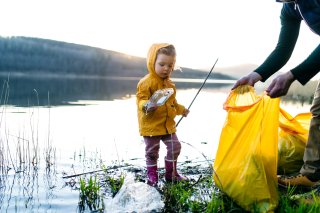About Plastic Products and Plastic Pollution
On this page:
About Plastic Products

Plastic products are generally versatile, durable and lightweight. Plastic products are prominent in the construction, transportation, and packaging industries. Plastic innovations contributed to many life-saving products that revolutionized the health care industry.
Plastic waste results from the production, use, and disposal of mono-material or multi-material plastic products. Mono-material products are made entirely from a single type of resin whereas multi-material products include one or more resin types, paper, or metal. EPA divides plastic products into three types for municipal solid waste purposes:
-
Containers and packaging. Containers and packaging include products such as plastic bags, containers, and wrapping material. These may be used to wrap or contain consumer goods (e.g., food, beverages, medications, cosmetic products, mattresses) and are often discarded in household waste.
-
Nondurable goods. Nondurable goods include products with a use lifespan of less than three years, such as plastic plates, cups, trash bags, disposable diapers, and clothing.
-
Durable goods. Durable goods consist of products that remain in use for longer than three years such as appliances, furniture, carpet, and consumer electronics.
Plastic products are primarily made from virgin fossil fuel feedstocks. The three types of plastic products are categorized into seven polymer types with resin codes, which are typically listed on materials using the icons in the graphic below. Understanding the different plastic polymer types is important because some recycling systems only accept certain types, meaning some plastic products may not be recyclable in those systems. Governments can develop polymer-specific solutions if certain products are commonly mismanaged or littered.
About Plastic Pollution

EPA’s estimates show that the amount of plastic waste in the United States' municipal solid waste system has grown continuously since 1960, with the greatest increases occurring between 1980 and 2000. Plastic waste generated in the U.S. increased from 0.4% of total municipal solid waste in 1960 to 12.2% in 2018, reaching 13.2% in 2017. This predominantly consists of containers and packaging, which includes single-use products, such as bags, wraps, and bottles—and does not include plastic waste from other sources, such as agricultural waste.
Plastic waste can intentionally or unintentionally enter the environment during the production, consumption, and disposal phases of the product lifecycle, though it is most common at the end of its useful life. Plastic pollution can originate from:
-
Resin pellets leaking during plastic production.
-
Mismanaged waste (e.g., waste collected but improperly or illegally disposed of or waste that is not collected in areas where solid waste management services exist).
-
Litter (e.g., items discarded in the environment).
-
Abrasion (e.g., “wear-and-tear”) and losses of microplastics.
-
Industrial and marine activities.
-
Catastrophic events.
-
Urban and stormwater runoff.
-
Washing machine wastewater.
Plastic pollution from land-based sources that ends up in oceans and waterways includes littered items such as packaging (e.g., flexible films), single-use products, durable consumer products, household products, and microplastics (e.g., tire wear particles and microfibers from textiles). Plastic pollution from sea-based sources can include abandoned, lost, or otherwise discarded boating, fishing, or aquaculture gear. The National Academies of Science, Engineering, and Medicine estimate that land-based sources account for up to 80% of plastic waste that pollutes waterways and oceans.
The U.S. plays a critical role in the global economy of plastic products. The Organisation for Economic Cooperation and Development estimates that the U.S. consumed 18% of global plastic products in 2019, and plastic use per capita was higher than in any other country globally. OECD also projects that, without interventions, global plastic use and waste will almost triple by 2060.
EPA released a strategy for how we can work collaboratively with U.S. state, Tribal, territorial, and local governments; industry and trade organizations; community organizations and NGOs; academia and consumers to prevent plastic pollution.
